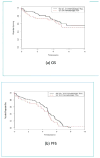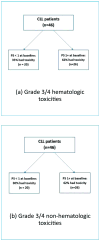Frequency and impact of grade three or four toxicities of novel agents on outcomes of older patients with chronic lymphocytic leukemia and non-Hodgkin lymphoma (alliance A151611)
- PMID: 29673807
- PMCID: PMC6015785
- DOI: 10.1016/j.jgo.2018.03.018
Frequency and impact of grade three or four toxicities of novel agents on outcomes of older patients with chronic lymphocytic leukemia and non-Hodgkin lymphoma (alliance A151611)
Abstract
Objective: Older patients with cancer suffer from chemotherapy-related toxicities more frequently than younger patients. As novel agents are being used more commonly in chronic lymphocytic leukemia (CLL) and non-Hodgkin lymphoma (NHL), toxicities of these agents in older patients have not been well studied. Further, impact of these toxicities on outcomes in the elderly is unknown. This study aimed to answer both questions.
Patients and methods: We reviewed 14 Alliance for Clinical Trials in Oncology trials that enrolled CLL and/or NHL patients between 2004-2014. Toxicity was assessed per the NCI-CTCAE (version 3-5). Probabilities of experiencing grade three or four hematologic and non-hematologic toxicities were modeled as a function of clinical and disease-related factors using logistic regression.
Results: 1199 patients (409 age ≥ 65; 790 age < 65) were analyzed; 438 received only biologic therapy (145 age ≥ 65; 293 age < 65), and 761 received biologic + chemotherapy (264 age ≥ 65; 497 age < 65). The odds of grade three or four hematologic [odds ratio (OR) 1.70; p = 0.009: 95% CI (1.57-1.84)] and non-hematologic toxicities [OR 1.47; p = 0.022; 95% CI (1.39-1.55)] were increased in older patients with CLL, as well as odds of grade three or four non-hematologic toxicities [OR 1.89; p = 0.017; 95% CI (1.64-2.17)] in older patients with NHL. Grade three or four hematologic toxicities were associated with inferior OS and PFS in older patients with NHL [HR 3.14; p = 0.006; 95% CI (2.25-4.39) for OS and 3.06; p = 0.011; 95% CI (2.10-4.45) for PFS], though not in CLL. A prognostic model predicting grade three or four toxicities was also developed.
Conclusions: CLL and NHL patients ≥ 65 year encounter more toxicities than younger patients even when treated with novel biologic agents. Development of grade three or four hematologic toxicities lead to inferior PFS and OS in NHL but not in CLL.
Keywords: Chronic lymphocytic leukemia; Non-Hodgkin lymphoma; Older patients; Toxicity.
Copyright © 2018 Elsevier Ltd. All rights reserved.
Conflict of interest statement
Advisory Boards: Bartlett, KITE, Pfizer, Seattle Genetics; Cheson, Roche-Genentech, Celgene, Pharmacyclics, Gilead.
Research Funding: Jatoi, NIH; Cheson, Roche-Genentech, Celgene, Pharmacyclics.
Figures



References
-
- SEER cancer statistics review, 1975–2013. Bethesda, MD, USA: National Cancer Institute; 2015.
-
- Nabhan C, Smith SM, Helenowski, et al. Analysis of very elderly (≥80 years) non-hodgkin lymphoma: impact of functional status and co-morbidities on outcome. Br J Haematol. 2012 Jan;156:196–204. - PubMed
-
- The Non-Hodgkin’s Lymphoma Classification Project: effect of age on the characteristics and clinical behavior of non-Hodgkin’s lymphoma patients. Ann Oncol. 1997;8:973–8. - PubMed
-
- Thieblemont C, Grossoeuvre A, Houot R, et al. Non-Hodgkin’s lymphoma in very elderly patients over 80 years. A descriptive analysis of clinical presentation and outcome. Ann Oncol. 2008;19:774–9. - PubMed
-
- Aoki K, Takahashi T, Tabata S, et al. Efficacy and tolerability of reduced-dose 21-day cycle rituximab and cyclophosphamide, doxorubicin, vincristine and prednisolone therapy for elderly patients with diffuse large B-cell lymphoma. Leuk Lymphoma. 2013;54:2441–7. - PubMed
Publication types
MeSH terms
Grants and funding
LinkOut - more resources
Full Text Sources
Other Literature Sources
Research Materials

